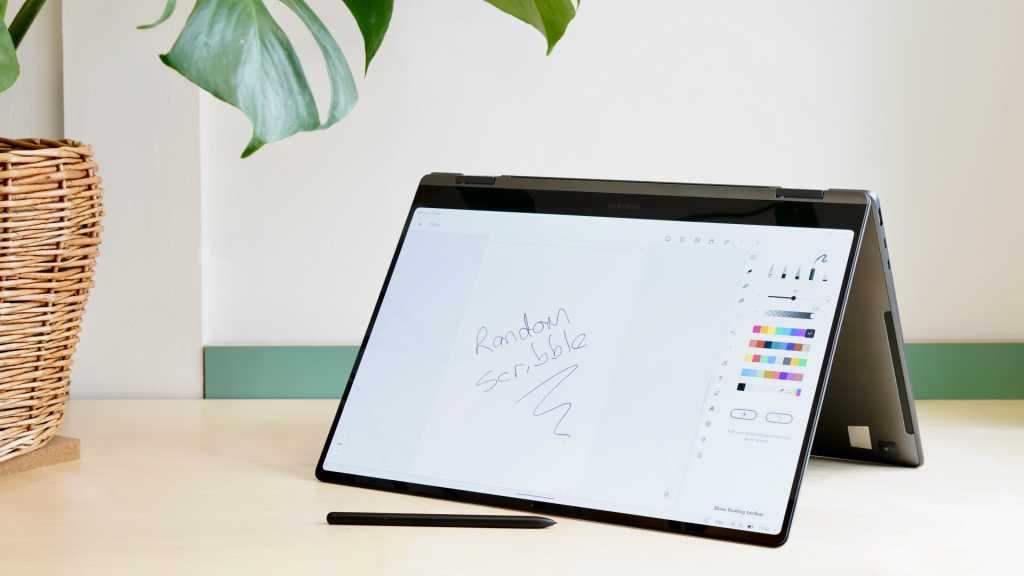Expert’s Rating
Pros
- Superb 120Hz AMOLED display
- Compromise-free design
- Solid performance
- S Pen included
Cons
- Not the best typing experience
- So so battery life
- No discrete GPU option
Our Verdict
Samsung has produced its best 2-in-1 yet, with an amazing 120Hz AMOLED display and a robust, refined design. It’s not quite the perfect package, but anyone who favours flexibility and input options above all else may just have found their ideal laptop.
Price When Reviewed
From $1,699.99
Best Prices Today: Samsung Galaxy Book3 Pro 360

$1699.99
$1899.99
Samsung is really getting back into the swing of things following its return to the laptop business in 2020. With last year’s Galaxy Book 2 Pro and Galaxy Book 2 360, it supplied extremely lightweight laptops that came up just a little short with a few key specifications.
The class of 2023 sees Samsung stepping things up on the spec front. Yes, the Galaxy Book 3 Pro 360 is another lightweight laptop-cum-tablet with an incredibly flexible display hinge. But it also packs a 120Hz 3K 16-inch AMOLED panel, 13th-gen Intel Core processors, and an S Pen stylus as standard.
It all suggests that Samsung might have produced an all-round champ that can be, if not all things to all people, then certainly most things to the majority of people. Wishful thinking, perhaps?
It’s another brilliant piece of engineering from a company that has gotten very good at this sort of thing
Design & Build
- 12.8mm
- From 1.66kg
- Aluminium build
At 12.8mm thick, the Samsung Galaxy Book 3 Pro 360 isn’t as appealingly skinny as last year’s 11.9mm Galaxy Book 2 Pro 360, but it is fractionally. The payoff is that it feels extremely robust. Despite the core design feature being that you can flip that display right around from a closed position to being back-to-back with the keyboard, it feels like a ‘normal’ laptop.
Talking of that hinge, it’s another brilliant piece of engineering from a company that has gotten very good at this sort of thing with its various laptops and foldable phones. The durability factor has apparently been upped with this year’s model, which would obviously take months or years to test rather than a couple of weeks. But like I said, the fact that it feels like a normal laptop is a testament to Samsung’s work.
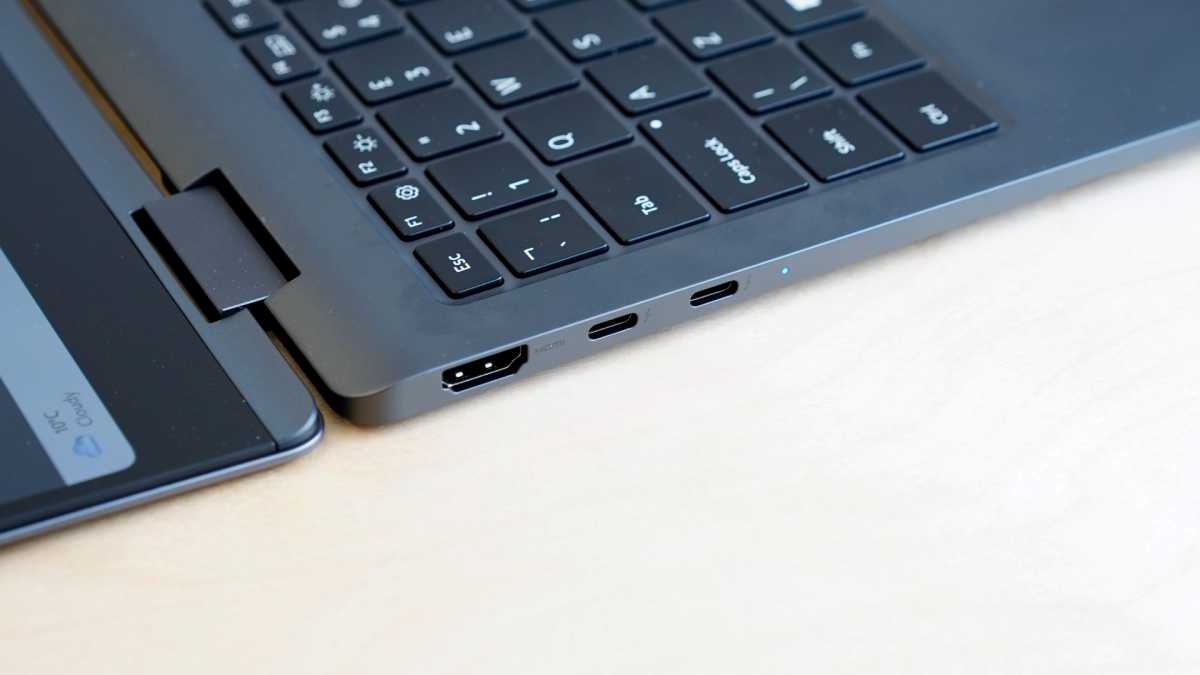
Jon Mundy / Foundry
No, this hinge doesn’t pass the one-thumb test, meaning I had to use my other hand to steady the chassis whilst opening, lest it skid off the back of my desk. But given the 360-degree feats that it’s capable of, I’m inclined to give Samsung a pass – especially given that a lot of expensive non-convertible laptops fail the test too.
To be clear, the Galaxy Book 3 Pro 360 screen doesn’t flatten right up against the keyboard when fully open, with either the rubber feet or the loosely attached S Pen maintaining a slight gap. But it still feels quite solid when used as effectively a super-sized tablet. The hinge also presents sufficient resistance when propped at a 135-degree angle, though any flatter and you might find that gravity takes a hold over time.
At 1.66kg for the Wi-Fi-only variant (which is what I tested) and 1.71kg for the 5G model, it’s appreciably light for a full-sized laptop. It’s nowhere near as light as the 1.16kg non-convertible Galaxy Book 2 Pro, but then few laptops are. Of course, this is also very heavy for a tablet, so you won’t be wielding the Galaxy Book 3 Pro 360 like an iPad when it’s fully opened out – not for long anyway.
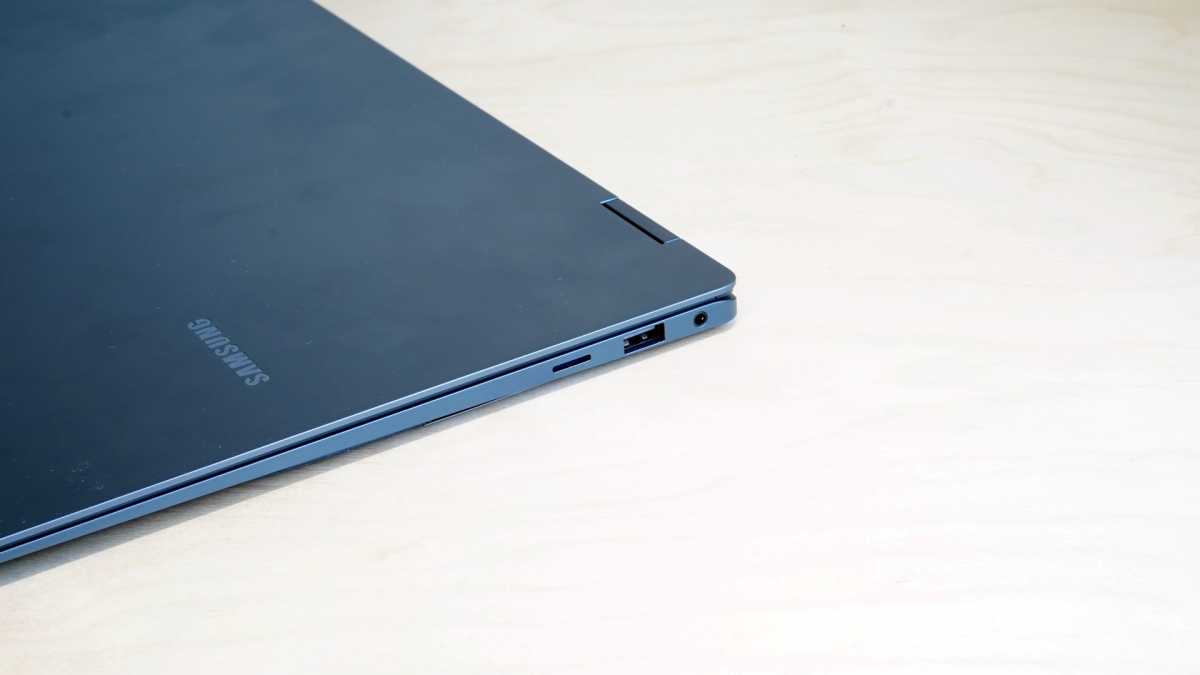
Jon Mundy / Foundry
You can specify the Book 3 Pro 360 in Graphite or Beige, both of which are built of premium aluminium. The latter colour might not sound all that appealing, but it might be worth considering if you’re averse to mucky fingerprints all over your gadgets. Within a few days of handling this Graphite model, I observed a seemingly permanent patina of grease across the lid.
The Samsung Galaxy Book 3 Pro 360 is well provisioned on the connectivity front compared to many thin rivals, starting with two USB-C ports available on the left-hand side (at least give us one on each, Samsung). But they are full Thunderbolt 4 ports, which is something.
Otherwise, you get a single USB-A port, a microSD slot (a regular SD slot would have been more useful), an HDMI slot, and a 3.5mm headphone jack. It’s a solid provision for a 2-in-1, perhaps, but not so much for a 16in laptop in the wider market.
There’s a 1080p webcam right above that display, too, which is always good to see.
Screen & Speakers
- 16in AMOLED
- 120Hz
- 3K resolution
We’re used to Samsung offering OLED displays in its laptops by now. What we’re not used to, and arguably this generation’s biggest contribution, is a 120Hz refresh rate.
It’s set to scale dynamically between 60- and 120Hz by default, but flip it into 120Hz only and it’s silky smooth scrolling all the way. It’ll hit your battery life something chronic, as I’ll go into later, but the option is most welcome for when you’re plugged into the mains.
Arguably this generation’s biggest contribution, is a 120Hz refresh rate
While this refresh rate is the most eye-catching part of the Samsung Galaxy Book 3 Pro 360 display, it’s not the only thing that impresses. This is a large 16in panel with a 16:10 aspect ratio, providing a sizable canvas for everything from image editing to sketching.
It’s extremely sharp too, with a 2880 x 1800 or 3K resolution, which is a big improvement over the 1080p Samsung Galaxy Book 2 Pro 360.
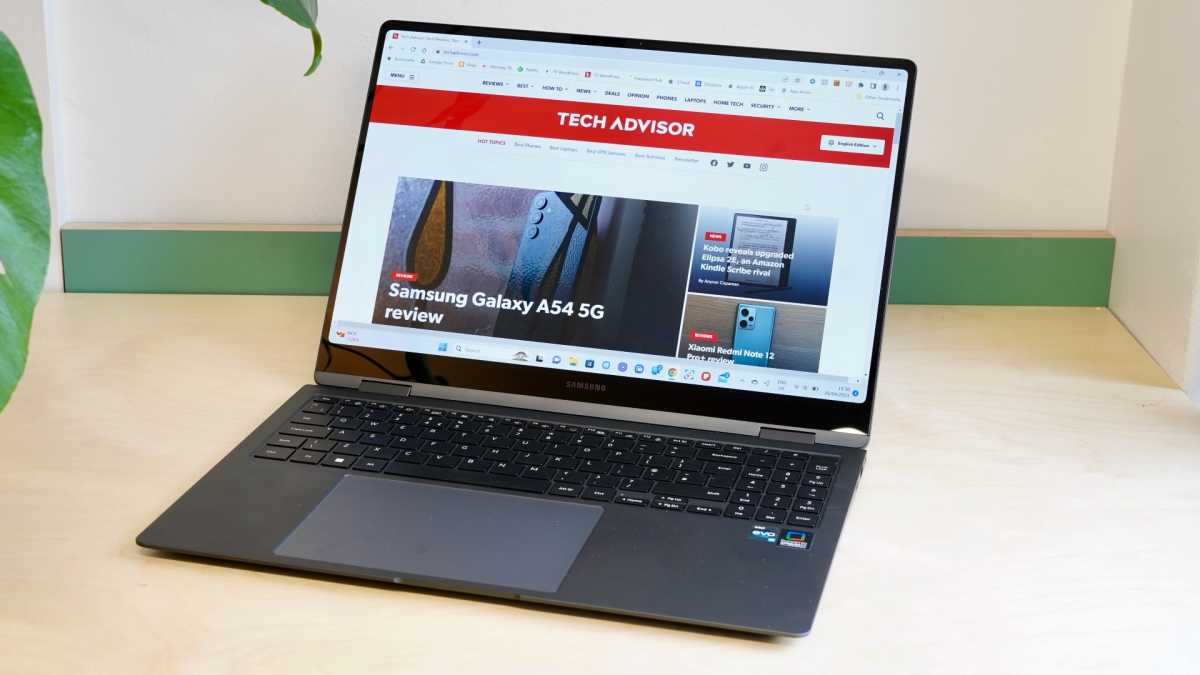
Jon Mundy / Foundry
This being an AMOLED panel, you can expect deep blacks and eye-poppingly vibrant colours. I recorded a gamut coverage of 99.9% sRGB, 95.3% Adobe RGB, and 99.4% DCI P3 in the default Auto colour profile, which is very strong and makes it suitable for the majority of creative work.
A peak brightness of 358 nits is nothing to write home about, so this isn’t the laptop to get if you’re planning on working outside a lot in the summer months. It’s just fine for indoor usage, however.
In terms of sound output, there’s an AKG-tuned quad-speaker system on board, with two 5W woofers and two 2W tweeters, as well as Dolby Atmos support. The sound is crisp and clear, but it lacks the bass and the rich spaciousness of a MacBook Pro, such that I didn’t feel inclined to listen to any music on it without hooking up a set of headphones but its more audio provision than many laptops.
Keyboard, Trackpad & S Pen
- Limited travel chiclet keyboard
- Large but off-center trackpad
- Bundled S Pen stylus
The typing experience on the Samsung Galaxy Book 3 Pro 360 is very accomplished, with a full-sized keyboard that includes a numerical pad and properly distinguished arrow keys. That’s a great start.
As for the actual keys, the low level of travel on these chiclet keys means that it falls a little short of the very best in the business. I much preferred typing on my MacBook Pro and indeed the non-chiclet Dell XPS 13 Plus, both of which provide a better feel leading to fewer typing errors. It’s still a decent provision, especially for a 2-in-1.
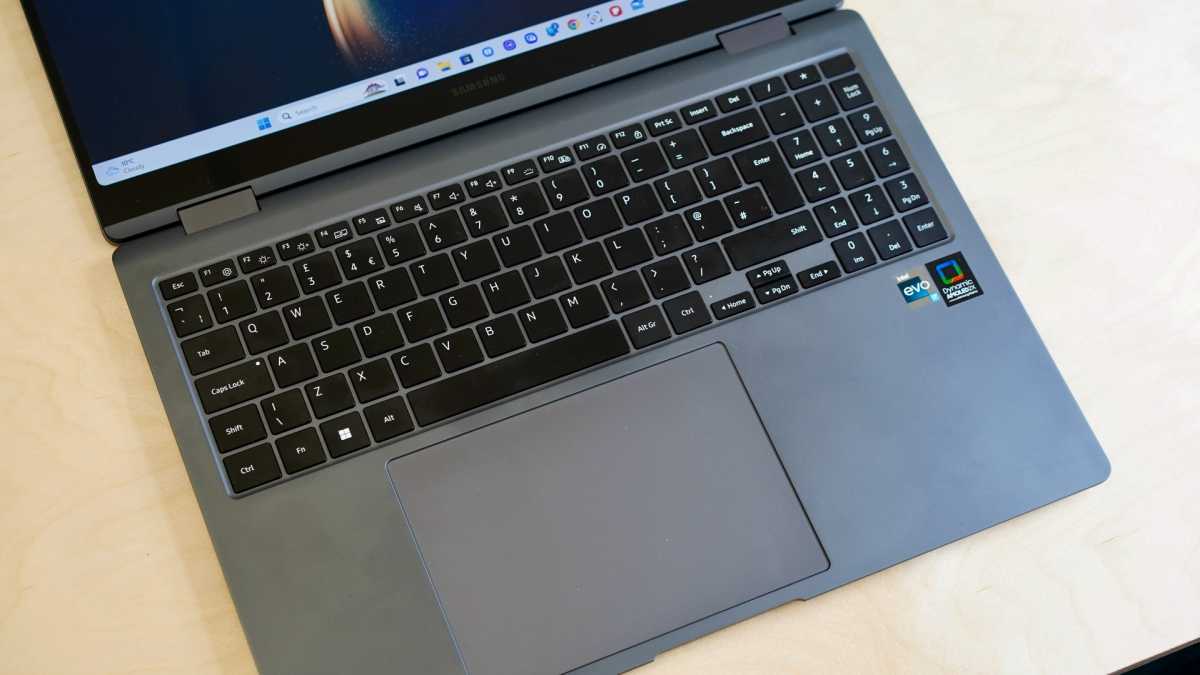
Jon Mundy / Foundry
You also get a decent fingerprint sensor built into the physical power button in the top right corner, which proved extremely reliable during my time with the laptop.
I’m not entirely happy with the Book 3’s trackpad, though. It’s plenty large enough, but the fact that it’s set slightly to one side really messed with my sense of what was a left-click and what was a right-click. I suspect I would adapt given more time, and it’s technically in line with the QWERTY keyboard (blame that lopsided numerical pad), but it’s not a wholly natural experience out of the box.
Mechanically speaking the trackpad is only clicky in the lower section, with physical rather than haptic feedback. Also, while the touchpad is sufficiently responsive in general broad sweeps navigation, I found it a little imprecise when doing subtler things like trying to finesse the position of a cursor in a document. I was relieved to hook up my mouse.
All in all, it gets nowhere near the subtle brilliance of a MacBook touchpad, which is the level Samsung needs to be judged against given its pedigree and pricing.
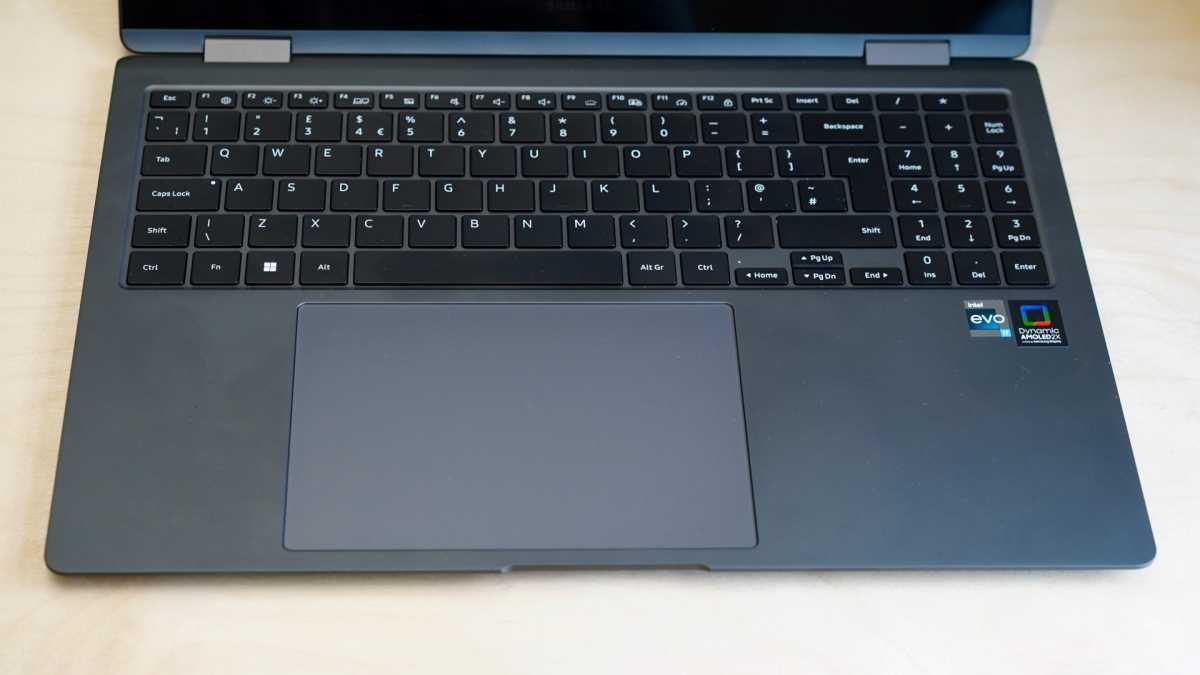
Jon Mundy / Foundry
Where Samsung knocks it out of the park on the input front is with its S Pen stylus, which comes bundled with every Samsung Galaxy Book 3 Pro 360. It stashes away on the lid of the laptop using magnets when not in use, which isn’t the most reassuringly secure fitting whilst you’re out and about.
When you are using it, however, the pressure sensitivity and sheer responsiveness make for a genuinely pen-like experience. Combined with that glorious display, it’s a great system for scrawling notes or sketches.
Specs & Performance
- 13th-gen Intel chips
- No discrete GPU option
- Up to 1TB storage
The Samsung Galaxy Book 3 Pro 360 runs on a 13th-gen Intel Core processors My test model ships with an i7-1360P and 16GB of RAM, while the base model comes with an i5-1340P with 8GB of RAM.
No, it’s not a match for the powerhouse that is the Samsung Galaxy Book 3 Ultra, but then few laptops right now are.
The generational advantage to its chip sees the Samsung Galaxy Book 3 Pro 360 besting those aforementioned Windows rivals quite handily
I had no problems using the Samsung Galaxy Book 3 Pro 360 for general work tasks. It zipped through multiple Chrome tabs, emails, 4K video streaming and more without breaking a sweat. I only noticed the fans kicking in from time to time, and they weren’t distractingly loud when they did.

Jon Mundy / Foundry
Naturally, this is no gaming laptop, with none of the discrete GPU options of the Ultra model. Older 3D titles like Portal 2 run just fine, but anything vaguely recent won’t run in optimal fashion. I was able to play through the open section of Star Wars Jedi: Fallen Order on the default Medium settings, but there were frequent halts and stutters as various cinematic elements loaded in.
In the CPU-focused Geekbench 5 multi-core test, the top variant of the Book 3 Pro 360 pips the Samsung Galaxy Book 2 Pro and the Dell XPS Plus 13 with their 12th gen Intel Core i7 processors. It also matches the MacBook Air M2, but predictably gets obliterated by the MacBook Pro M2 Pro.
When it comes to our usual GPU benchmarks, the generational advantage to its chip sees the Samsung Galaxy Book 3 Pro 360 besting those aforementioned Windows rivals quite handily.
Storage options are suitably varied, with 256GB, 512GB, and 1TB all on the table. You’ll need to take the faster processor and higher RAM allotment at 16GB not 8GB if you want the more capacious SSD options, however.
Battery Life & Charging
The Samsung Galaxy Book 3 Pro 360 packs a reasonably large 76Wh battery, which broadly provides the kind of stamina we’ve come to expect from a modern Windows 11 laptop. In other words, not horrendous, but still not quite good enough for a full working day, certainly nothing to trouble an Apple silicon MacBook.
In light work conditions, which involved predominantly Chrome-based browsing and Google Doc usage, a smattering of YouTube videos, and regular email and Slack usage, I found that the Book 3 Pro 360 would show the critical battery warning (at around 6%) after 7 hours of usage, with a lunch break thrown in.
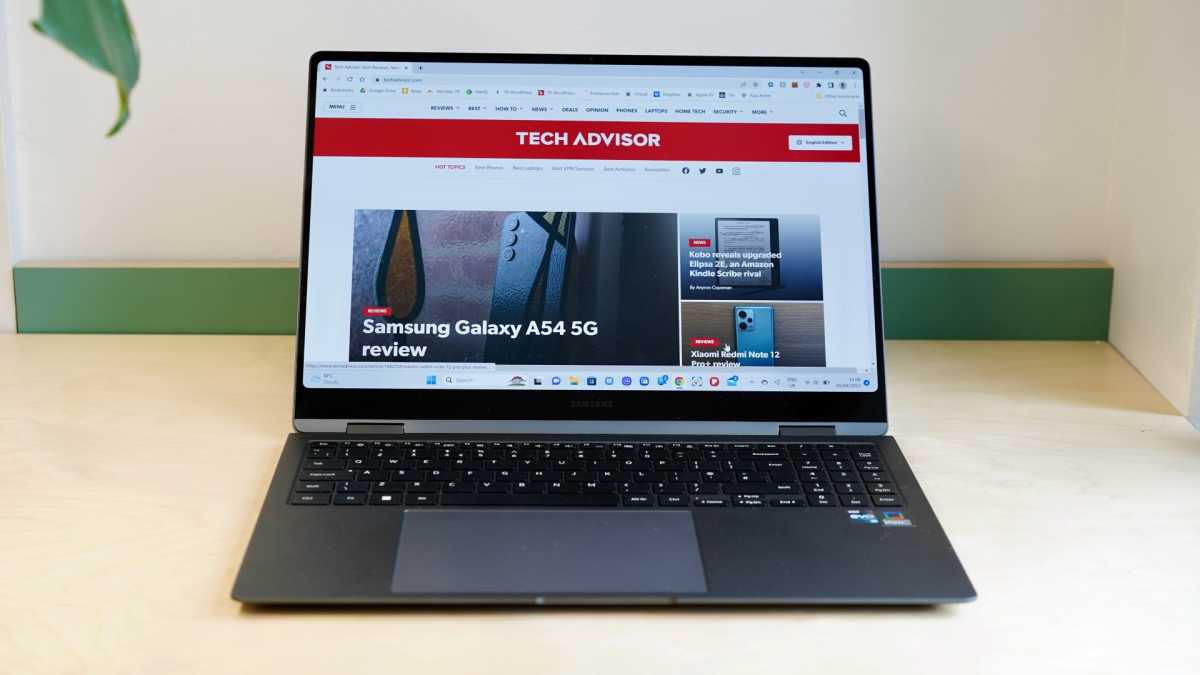
Jon Mundy / Foundry
This was with the screen set to an adaptive refresh rate and with HDR turned off, which is the default state. With 120Hz and HDR active, the laptop would only get through 4 hours of such a typical work day.
Our usual looping 720p video test, with the screen brightness set to a fairly dim 120 nits, ran for 14h 26m before powering down. That’s about half an hour less than the Samsung Galaxy Book 2 360, and is well short of the LG Gram 16 (not to mention those MacBooks), but is otherwise far from the worst result we’ve seen.
Come recharge time, Samsng bundles in its usual 65W brick. I clocked the charging rate at 37% over the first 30 minutes from a powered down state. That’s not as speedy as the Galaxy Book 2 360, but it’s about right for the size and spec of the laptop. A full charge will take just under 1 hour 45 minutes.
All in all, this is perhaps the one fundamental area that holds the Galaxy Book 3 Pro 360 back from being the all-round great it could be. If Samsung can engineer a 2-in-1 that can reliably get through a full working day on a single charge, they’d really be in…
